It wasn’t enough for Fulham to simply return to the Premier League. The club wanted to stay up with style. Owner Shahid Khan did not approach this pursuit half-heartedly. He locked down Tom Cairney and 18-year-old Championship Player of the Season Ryan Sessegnon, and then backed manager Slavisa Jokanovic in the transfer market to the tune of £100 million. This expenditure has not just been plentiful but largely seen as well-scouted and soundly considered.. The most eye-catching signing of the bunch was central midfielder Jean-Michael Seri, a player linked with a strong share of the world’s elite clubs. While the eye-popping sums of money Fulham threw about surely turned turned off some, Fulham’s sexy style of play and intelligent expenditure had most neutrals intrigued. Their return to England’s top division had the potential to be a celebration of football, but, nine games in, Fulham have dropped into the relegation zone, a fact which should come as no surprise considering their expected goal difference of negative 0.97, the second worst in the Premier League A team averaging 530 passes per game, the seventh most in the league, while losing games is certain to bring the familiar faces of punditocracy’s old guard out of the woodwork. They bring with them questions over whether newly promoted teams can succeed while playing a possession based brand of football. There are some issues within Fulham’s play on the ball. There’s a general lack of organisation, that is to say, it doesn’t appear as if Jokanovic is utilising a positional play system that is the supporting structure of all of the world’s best possession coaches, with perhaps the exception of Maurizio Sarri. Further, Jokanovic’s temptation to start games with both Sessegnon and Schurrle, two players whose major contribution to attacking play is to arrive in the box at the right moment to make their first touch a shot, is going to have an inevitable effect on final third play which may be connected to Fulham’s tendency to shoot from distance. Schurrle is a particularly egregious culprit. 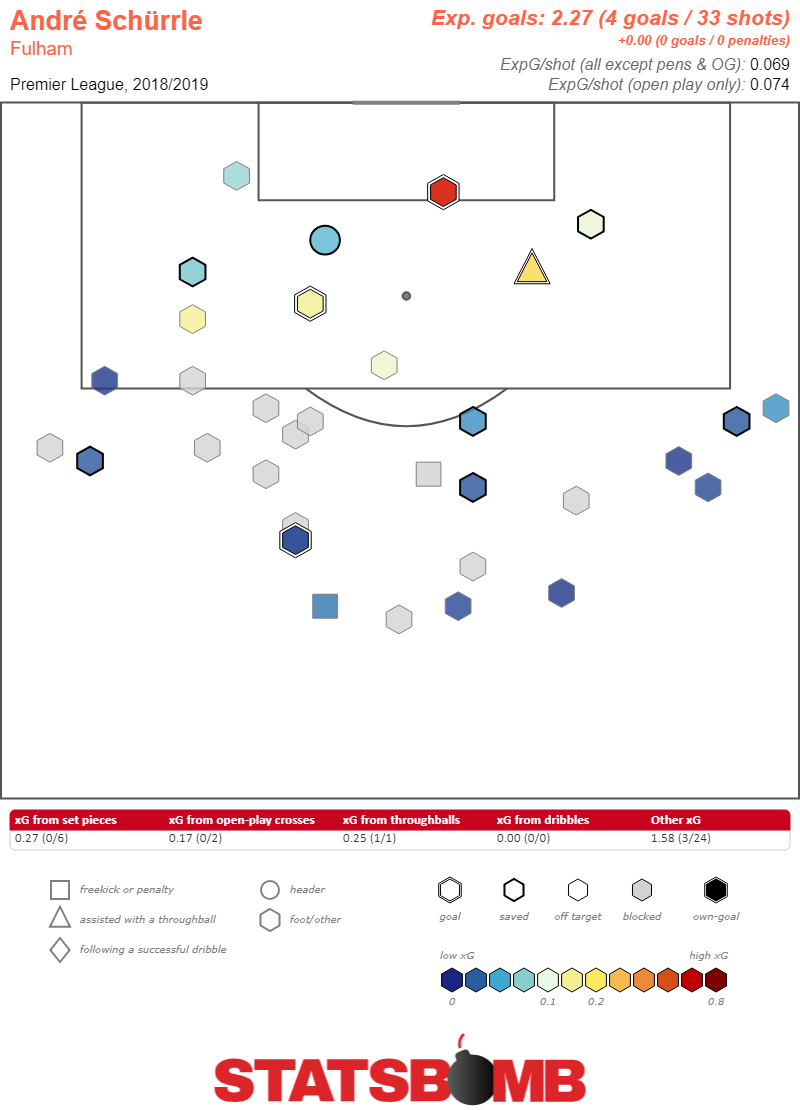 These quibbles in mind, Fulham’s attacking xG of 1.12 is still better than seven other sides, despite having already played Spurs, Man City and Arsenal. They can aspire to improve in this department but so far it seems their attacking efforts can largely be interpreted as functional is not outstanding. It is the other end of the pitch which is the issue, with The Cottagers having conceded the highest number of both expected (2.10 per match) and actual (25) goals. Fulham’s dedication to passing sees the ball somewhat regularly stolen from a defender or deep midfielder before a dangerous attack immediately ensuing for the opposition. These turnovers are always the most visceral argument against a short passing game but, to an extent, they might just be an acceptable systemic tradeoff, just as any tactical method has its own strengths and vulnerabilities. Fulham’s success or failure either way will in no way provide a definitive answer to the question of promotion sides and possession football. The mould has already been broken by Swansea under Brendan Rodgers and Michael Laudrup, Southampton under Mauricio Pochettino and to a lesser extent Bournemouth under Eddie Howe. However, just as all three of these teams have shared similarities on the ball they also have a familiar method off of it, namely, counter-pressing. Conventional coaching knowledge tells us that if you want to push your entire team forward and play the game in the opposition’s half of the pitch then you need to be defending in those areas too. Via the defensive activity map we can see this is going catastrophically badly. Exactly where Fulham need to be exceeding average activity they are instead almost entirely absent. The map also highlights a horizontal imbalance in their own defensive third. Whether that’s a reaction to being repeatedly targeted on one side or an inability to perform defensive actions on the opposite is a big issue either way.
These quibbles in mind, Fulham’s attacking xG of 1.12 is still better than seven other sides, despite having already played Spurs, Man City and Arsenal. They can aspire to improve in this department but so far it seems their attacking efforts can largely be interpreted as functional is not outstanding. It is the other end of the pitch which is the issue, with The Cottagers having conceded the highest number of both expected (2.10 per match) and actual (25) goals. Fulham’s dedication to passing sees the ball somewhat regularly stolen from a defender or deep midfielder before a dangerous attack immediately ensuing for the opposition. These turnovers are always the most visceral argument against a short passing game but, to an extent, they might just be an acceptable systemic tradeoff, just as any tactical method has its own strengths and vulnerabilities. Fulham’s success or failure either way will in no way provide a definitive answer to the question of promotion sides and possession football. The mould has already been broken by Swansea under Brendan Rodgers and Michael Laudrup, Southampton under Mauricio Pochettino and to a lesser extent Bournemouth under Eddie Howe. However, just as all three of these teams have shared similarities on the ball they also have a familiar method off of it, namely, counter-pressing. Conventional coaching knowledge tells us that if you want to push your entire team forward and play the game in the opposition’s half of the pitch then you need to be defending in those areas too. Via the defensive activity map we can see this is going catastrophically badly. Exactly where Fulham need to be exceeding average activity they are instead almost entirely absent. The map also highlights a horizontal imbalance in their own defensive third. Whether that’s a reaction to being repeatedly targeted on one side or an inability to perform defensive actions on the opposite is a big issue either way. 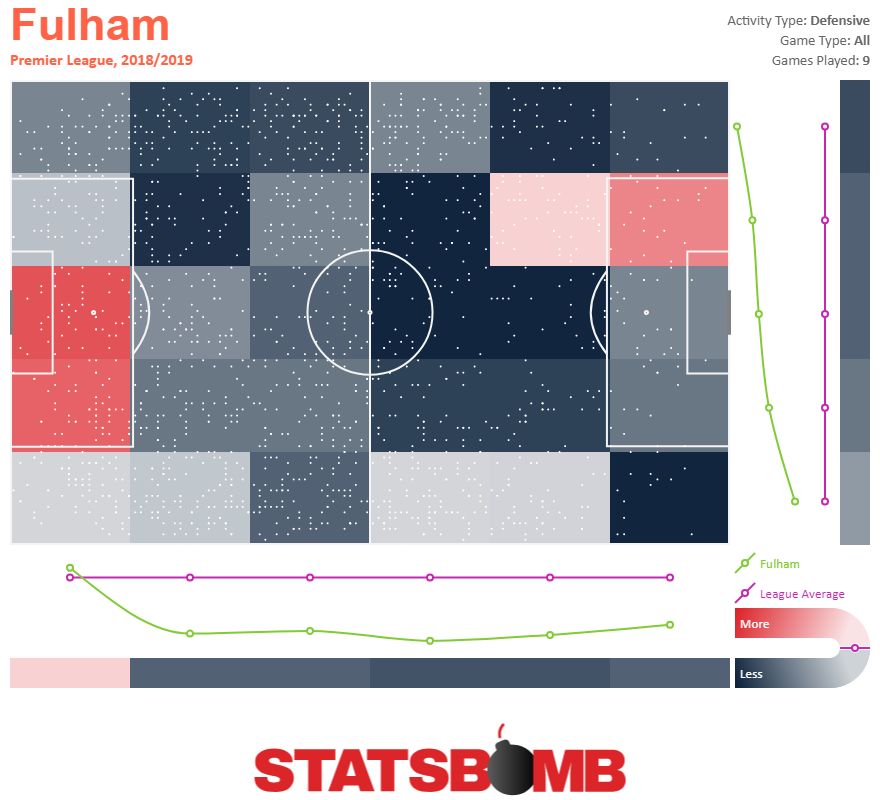 The term counter-pressing means exactly that - apply pressure to the counter-attack. Fulham’s failure to do that leaves them vulnerable. Failing to stop counter-attacks far from goal is how a team that has so much of the ball also ends up leading the league in passes allowed in their own penalty area.
The term counter-pressing means exactly that - apply pressure to the counter-attack. Fulham’s failure to do that leaves them vulnerable. Failing to stop counter-attacks far from goal is how a team that has so much of the ball also ends up leading the league in passes allowed in their own penalty area. 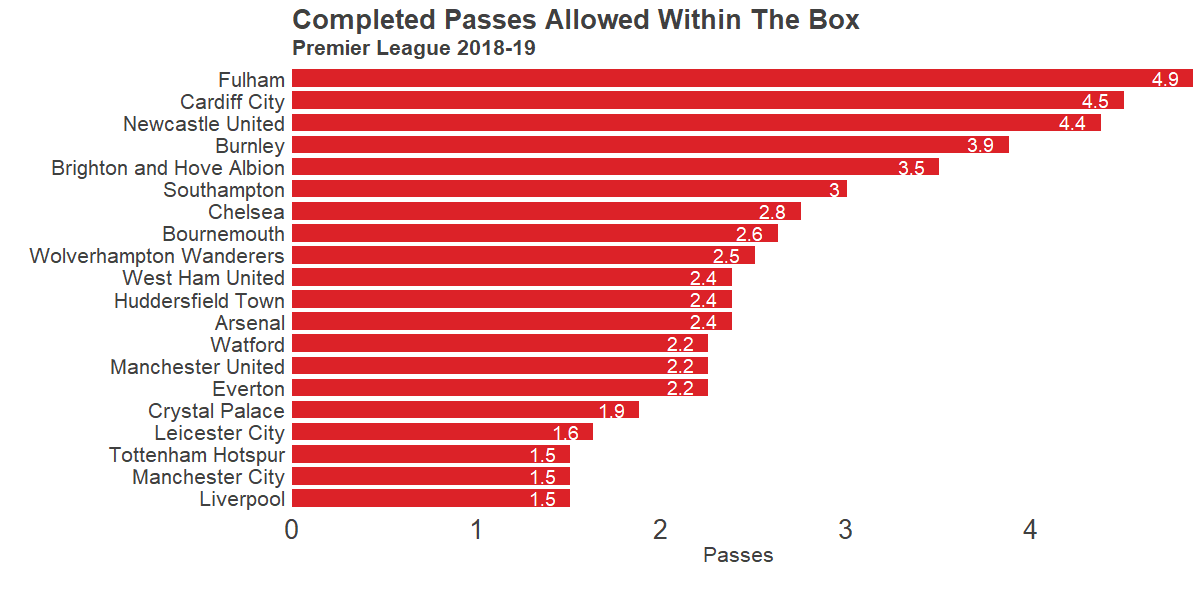 But this style of play is not new to Fulham this season and neither is the manager. Jokanovic is fully aware of these issues and has demonstrated his ability to coach an efficient counter-pressing system as he achieved promotion with the club. Fulham finished in third place before winning the playoffs. They had the highest average share of possession throughout the season and conceded a, for the Championship, respectable single goal per game, showcasing their ability to control the opposition. https://giphy.com/gifs/fulham-pressing-derby-ljzyPiVfRWutEI3OJz The reality is developing a counter-pressing system takes time. Just look at the difference between first and second year Guardiola’s Man City, or Sarri and Emery’s current shaky starts - at least in the underlying numbers - this season. Reading and reacting to an opposition misplaced pass. Chasing forward without hesitating to check behind for your teammate picking up the player you’re leaving behind. Stepping up from the defensive line when instinct tells you to retreat. All these things require a level of group cohesion that can not be found over the course of a single pre-season, heavily interrupted by glamour friendlies. These challenges can be seen in specific relation to Jokanovic’s style of play as he arrived at a Fulham side in the Championship, gradually taking them from relegation threat to 3rd place over the course of two and a half seasons. The large investment into the squad, while likely needed to adapt to a considerably higher level of competition, can also act as something of a reset for the manager’s coaching process. Given all this, patience carries a considerable value but with every dropped point the pressure mounts. If there is one team Fulham should be beating it’s Cardiff with their very Championship squad and style of play. Instead, they conceded four goals, a result which was a fair, if slightly exaggerated, representation of their performance on the day
But this style of play is not new to Fulham this season and neither is the manager. Jokanovic is fully aware of these issues and has demonstrated his ability to coach an efficient counter-pressing system as he achieved promotion with the club. Fulham finished in third place before winning the playoffs. They had the highest average share of possession throughout the season and conceded a, for the Championship, respectable single goal per game, showcasing their ability to control the opposition. https://giphy.com/gifs/fulham-pressing-derby-ljzyPiVfRWutEI3OJz The reality is developing a counter-pressing system takes time. Just look at the difference between first and second year Guardiola’s Man City, or Sarri and Emery’s current shaky starts - at least in the underlying numbers - this season. Reading and reacting to an opposition misplaced pass. Chasing forward without hesitating to check behind for your teammate picking up the player you’re leaving behind. Stepping up from the defensive line when instinct tells you to retreat. All these things require a level of group cohesion that can not be found over the course of a single pre-season, heavily interrupted by glamour friendlies. These challenges can be seen in specific relation to Jokanovic’s style of play as he arrived at a Fulham side in the Championship, gradually taking them from relegation threat to 3rd place over the course of two and a half seasons. The large investment into the squad, while likely needed to adapt to a considerably higher level of competition, can also act as something of a reset for the manager’s coaching process. Given all this, patience carries a considerable value but with every dropped point the pressure mounts. If there is one team Fulham should be beating it’s Cardiff with their very Championship squad and style of play. Instead, they conceded four goals, a result which was a fair, if slightly exaggerated, representation of their performance on the day 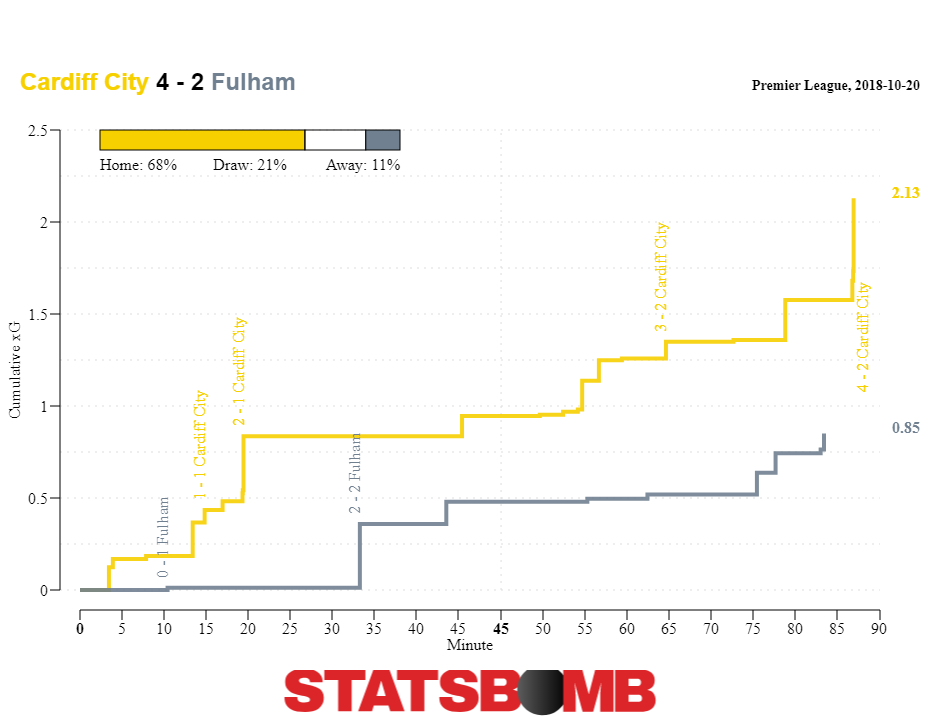 If the board are considering reaction to the results thus far then they should likely consider Jokanovic and possession football as one and the same. His ability to coach it appears high level, and Fulham will have a hard time finding someone who can enact a pressing method quicker than he can. A panic move away from Jokanovic, therefore should also be a move away from the possession approach. Given the squad the club have put together and the money spent in doing so this may well be considered a risky approach in of itself. Just as Swansea and Southampton have demonstrated the viability of possession football for bottom 14 sides they also highlight the dangers in moving away from it with the former relegated and the latter under threat having moved to a more direct approach. The real question for Khan then, is not the suitability of the play-style to the league, or the manager to the challenge, but the new players to the pressing system - and the difficulty of applying it in such a high quality league. It’s probably safe to be optimistic over interception monster Andre-Frank Zambo Anguissa and ex-Dortmund player Andre Schurrle. If we consider Seri, though excellent on the ball, the most ‘leightweight’ of the new players and also operating in a crucial midfield role then we may have concern over his output of more traditional defensive metrics. However, nearly three pressure regains per90 for Nice last seasons suggests he should at least have a means of contributing defensively.
If the board are considering reaction to the results thus far then they should likely consider Jokanovic and possession football as one and the same. His ability to coach it appears high level, and Fulham will have a hard time finding someone who can enact a pressing method quicker than he can. A panic move away from Jokanovic, therefore should also be a move away from the possession approach. Given the squad the club have put together and the money spent in doing so this may well be considered a risky approach in of itself. Just as Swansea and Southampton have demonstrated the viability of possession football for bottom 14 sides they also highlight the dangers in moving away from it with the former relegated and the latter under threat having moved to a more direct approach. The real question for Khan then, is not the suitability of the play-style to the league, or the manager to the challenge, but the new players to the pressing system - and the difficulty of applying it in such a high quality league. It’s probably safe to be optimistic over interception monster Andre-Frank Zambo Anguissa and ex-Dortmund player Andre Schurrle. If we consider Seri, though excellent on the ball, the most ‘leightweight’ of the new players and also operating in a crucial midfield role then we may have concern over his output of more traditional defensive metrics. However, nearly three pressure regains per90 for Nice last seasons suggests he should at least have a means of contributing defensively. 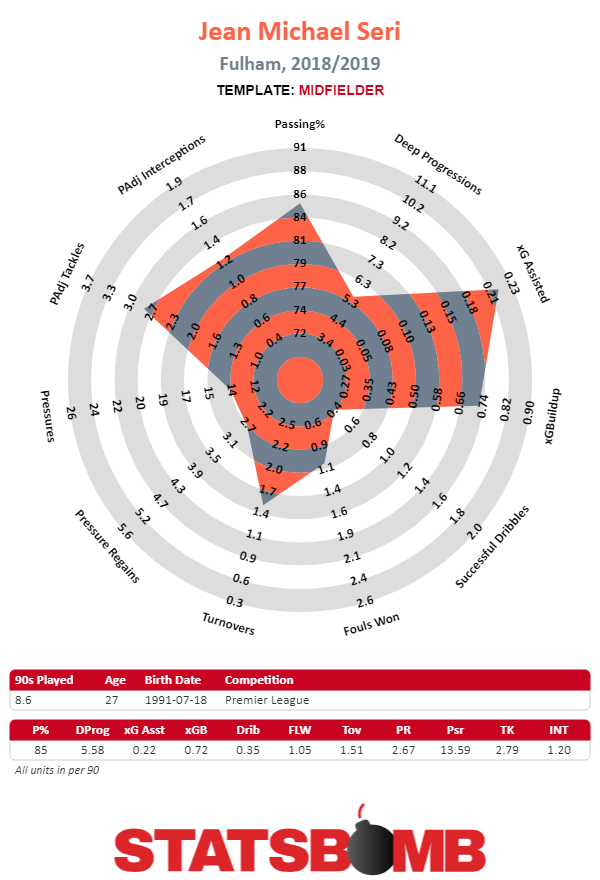 Jokanovic has yet to start a game with the midfield trio that would be considered their first choice - Anguissa, Cairney and Seri - perhaps this could be considered reason not to judge them on this short sample. Further, he has trialled a two man midfield, a three man defence and in the process put no less than seventeen players on more than 250 league minutes. These changes, likely attempting to find a balance between the systemically established players of old and the higher talent ceiling of new, all while managing early season fitness, hits the catch 22 of stalling the growth of cohesion while attempting to find the formula in which to grow it - and win games in the process. As the aforementioned Rodgers once said, managing a football club is like building a plane while it’s in the air. While Fulham may be struggling to take flight right now, changing the architect mid season will only make an ultimate crash more likely. Header Image courtesy of the Press Association
Jokanovic has yet to start a game with the midfield trio that would be considered their first choice - Anguissa, Cairney and Seri - perhaps this could be considered reason not to judge them on this short sample. Further, he has trialled a two man midfield, a three man defence and in the process put no less than seventeen players on more than 250 league minutes. These changes, likely attempting to find a balance between the systemically established players of old and the higher talent ceiling of new, all while managing early season fitness, hits the catch 22 of stalling the growth of cohesion while attempting to find the formula in which to grow it - and win games in the process. As the aforementioned Rodgers once said, managing a football club is like building a plane while it’s in the air. While Fulham may be struggling to take flight right now, changing the architect mid season will only make an ultimate crash more likely. Header Image courtesy of the Press Association
2018
Will Fulham's Substance Ever Match Their Style?
By admin
|
October 26, 2018
